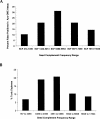Experimental validation of the importance of seed complement frequency to siRNA specificity
- PMID: 18367722
- PMCID: PMC2327361
- DOI: 10.1261/rna.704708
Experimental validation of the importance of seed complement frequency to siRNA specificity
Abstract
Pairing between the hexamer seed region of a small interfering RNA (siRNA) guide strand (nucleotides 2-7) and complementary sequences in the 3' UTR of mature transcripts has been implicated as an important element in off-target gene regulation and false positive phenotypes. To better understand the association between seed sequences and off-target profiles we performed an analysis of all possible (4096) hexamers and identified a nonuniform distribution of hexamer frequencies across the 3' UTR transcriptome. Subsequent microarray analysis of cells transfected with siRNAs having seeds with low, medium, or high seed complement frequencies (SCFs) revealed that duplexes with low SCFs generally induced fewer off-targets and off-target phenotypes than molecules with more abundant 3' UTR complements. These findings provide the first experimentally validated strategy for designing siRNAs with enhanced specificity and allow for more accurate interpretation of high throughput screening data generated with existing siRNA/shRNA collections.
Figures





Similar articles
-
Single base mismatches in the mRNA target site allow specific seed region-mediated off-target binding of siRNA targeting human coagulation factor 7.RNA Biol. 2012 Jan;9(1):87-97. doi: 10.4161/rna.9.1.18121. Epub 2012 Jan 1. RNA Biol. 2012. PMID: 22258146 Free PMC article.
-
Asymmetric RNA duplexes mediate RNA interference in mammalian cells.Nat Biotechnol. 2008 Dec;26(12):1379-82. doi: 10.1038/nbt.1512. Epub 2008 Nov 23. Nat Biotechnol. 2008. PMID: 19029911
-
3' UTR seed matches, but not overall identity, are associated with RNAi off-targets.Nat Methods. 2006 Mar;3(3):199-204. doi: 10.1038/nmeth854. Nat Methods. 2006. PMID: 16489337
-
Is the Efficiency of RNA Silencing Evolutionarily Regulated?Int J Mol Sci. 2016 May 12;17(5):719. doi: 10.3390/ijms17050719. Int J Mol Sci. 2016. PMID: 27187367 Free PMC article. Review.
-
DISE: A Seed-Dependent RNAi Off-Target Effect That Kills Cancer Cells.Trends Cancer. 2018 Jan;4(1):10-19. doi: 10.1016/j.trecan.2017.11.007. Epub 2018 Jan 8. Trends Cancer. 2018. PMID: 29413418 Free PMC article. Review.
Cited by
-
Expanding the microRNA targeting code: functional sites with centered pairing.Mol Cell. 2010 Jun 25;38(6):789-802. doi: 10.1016/j.molcel.2010.06.005. Mol Cell. 2010. PMID: 20620952 Free PMC article.
-
In vivo efficacy and off-target effects of locked nucleic acid (LNA) and unlocked nucleic acid (UNA) modified siRNA and small internally segmented interfering RNA (sisiRNA) in mice bearing human tumor xenografts.Artif DNA PNA XNA. 2010 Jul;1(1):36-44. doi: 10.4161/adna.1.1.12204. Artif DNA PNA XNA. 2010. PMID: 21687525 Free PMC article.
-
Excessive endometrial PlGF- Rac1 signalling underlies endometrial cell stiffness linked to pre-eclampsia.Commun Biol. 2024 May 4;7(1):530. doi: 10.1038/s42003-024-06220-7. Commun Biol. 2024. PMID: 38704457 Free PMC article.
-
Identifying Cleaved and Noncleaved Targets of Small Interfering RNAs and MicroRNAs in Mammalian Cells by SpyCLIP.Mol Ther Nucleic Acids. 2020 Oct 14;22:900-909. doi: 10.1016/j.omtn.2020.10.009. eCollection 2020 Dec 4. Mol Ther Nucleic Acids. 2020. PMID: 33251041 Free PMC article.
-
Base-Editor-Mediated circRNA Knockout by Targeting Predominantly Back-Splice Sites.Methods Mol Biol. 2024;2765:193-208. doi: 10.1007/978-1-0716-3678-7_11. Methods Mol Biol. 2024. PMID: 38381341
References
-
- Bartel, D. MicroRNAs: Genomics, biogenesis, mechanism, and function. Cell. 2004;116:281–297. - PubMed
-
- Birmingham, A., Anderson, E.M., Reynolds, A., Ilsley-Tyree, D., Leake, D., Fedorov, Y., Baskerville, S., Maksimova, E., Robinson, K., Karpilow, J., et al. 3′ UTR seed matches, but not overall identity, are associated with RNAi off-targets. Nat. Methods. 2006;3:199–204. - PubMed
-
- Chatterjee-Kishore, M., Miller, C.P. Exploring the sounds of silence: RNAi-mediated gene silencing for target identification and validation. Drug Discov. Today. 2005;10:1559–1565. - PubMed
Publication types
MeSH terms
Substances
LinkOut - more resources
Full Text Sources
Other Literature Sources
Molecular Biology Databases
